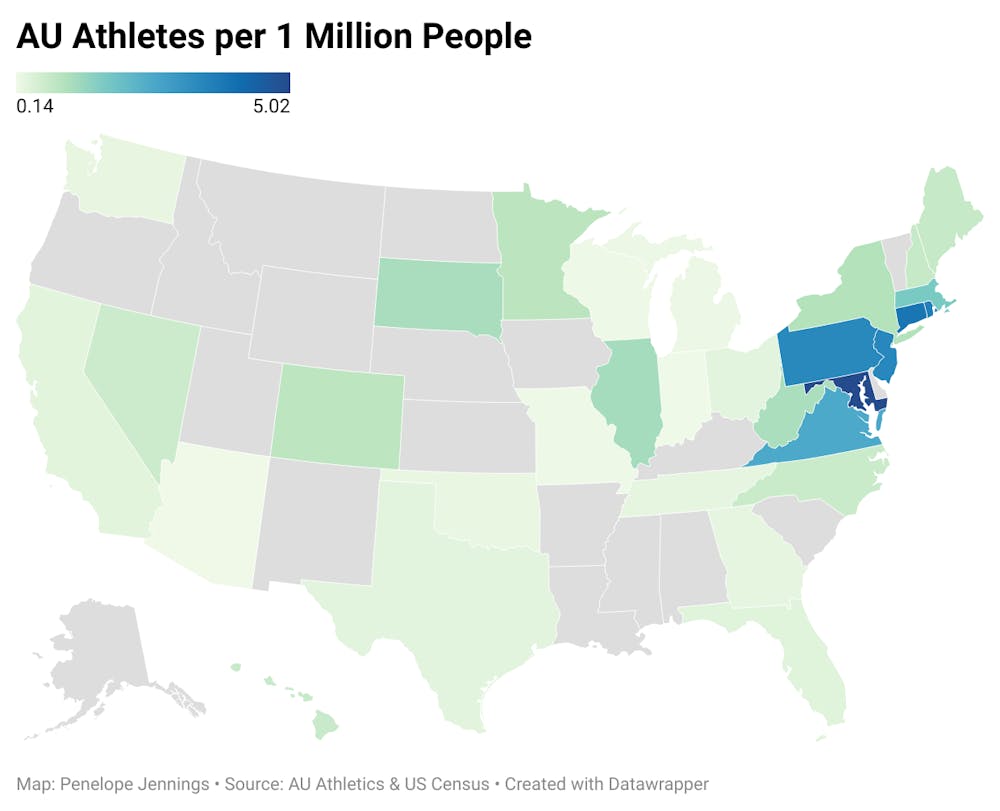From the Newsstands: This story appeared in The Eagle's April 2024 print edition. You can find the digital version here.
American University draws students from far and wide, including for its student-athlete population. A large portion of AU athletes are recruited from the Northeast, but athletes also travel from the Midwest and West Coast. Closer to the University, there are plenty of athletes from states surrounding the District, but there are no AU athletes currently listed as hailing from D.C.
Georgetown, George Washington and Howard all have at least one athlete from D.C. on their men’s basketball teams alone. So why doesn’t AU?
Next year, new women’s soccer commit Maddie Hurowitz will become AU’s only D.C.-native athlete. Hurowitz is from the District and will stay close to home next year.
“I'm really excited that my parents are pretty much gonna be able to come to every single game,” Hurowitz said. “I feel like a support system is super important in soccer and college in general. So to be able to like have some people to lean on will be really nice.”
Hurowitz currently attends BASIS DC and plays for the Alexandria Soccer Association. AU coaches first saw her play when she attended their ID camp in April 2023 where high school athletes had the chance to show their skills to American’s coaches and play with some current AU athletes.
Pennsylvania leads all states for AU’s recruiting by a large margin — with 44 athletes hailing from the Keystone State. New Jersey follows with 32 athletes and Maryland is close behind with 31. There is at least one athlete on every single team from both Pennsylvania and New Jersey, and just two teams, women’s basketball and field hockey, are without a Marylander.
Adjusting for population can paint a fuller picture. Maryland leads with the greatest number of AU athletes per capita. For about every one million people in Maryland, five of them are American University athletes. So while athletes may not be coming directly from D.C. to AU, there are plenty from the area competing for the Eagles.

American is also known for its large international student population — as 10.6 percent of undergraduate students are international. Similarly, 8 percent of the student-athlete population is international. The figures are alike, but the percentage of athletes from countries outside of the U.S. is still smaller than one might expect.

The women’s soccer team is one of two teams at American without an international athlete, with lacrosse being the other. Lacrosse as a whole is much more popular in the U.S. than in the rest of the world, but soccer is famously an international sport.
Women’s soccer’s absence of international players is not due to a lack of trying – the program is not fully funded, meaning they do not offer the maximum amount of scholarships allowed. This can make it more difficult for international players to commit to playing at a school where they may not receive a full scholarship.
“Our ability to go out and see them is limited also because of budget and recruiting budget and all those sorts of things,” women’s soccer head coach Marsha Harper said.
On average, American University spends about $17,000 per team on recruiting for its eight women’s sports. Meanwhile, they spend an average of $24,000 per team on recruiting for each of their six men’s sports, according to Equity in Athletics. The women’s soccer team has no international players while the men’s team has four.

The field hockey team has the highest percentage of international students, compared to other AU teams. There are 24 total players on the team. Seventeen are from the U.S., two from Argentina, two from South Africa, one from England, one from Germany and one from the Netherlands. In addition to having the greatest number of international players, they also have players from the greatest number of different countries with six. Men’s soccer follows close behind with five unique countries represented.
“I would definitely love to have some international student-athletes,” Harper said. “But that's kind of our situation, we're working on it.”
As for why American doesn’t have more student-athletes from the District, part of the problem is a lack of club teams within D.C. Many are based in Maryland or Virginia and draw talented players away from the District itself, according to Harper.
“One thing that our staff tried to do consciously when we got here was create a relationship with the local clubs because we noticed too, there weren't even players from D.C. or Virginia at the time we first came in,” Harper said. “I think there's one club that is in D.C. in particular, which makes it hard just from just the player pool standpoint.”
This article was edited by Delaney Hoke and Abigail Pritchard. Copy editing done by Luna Jinks, Isabelle Kravis, Liah Argiropoulos, Sarah Clayton and Ariana Kavoossi.





